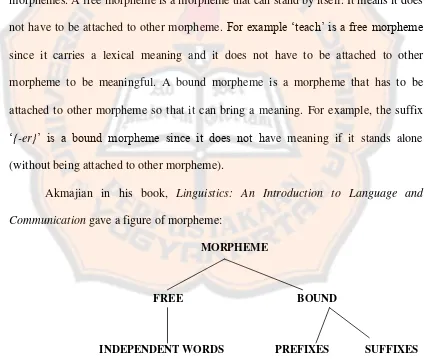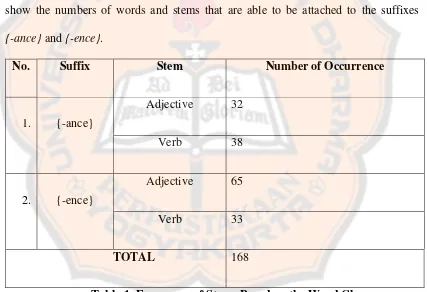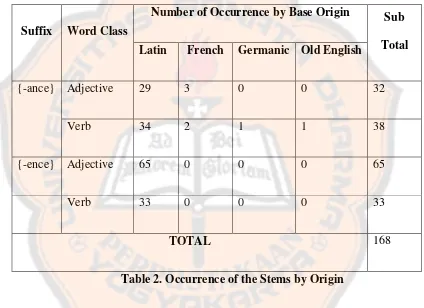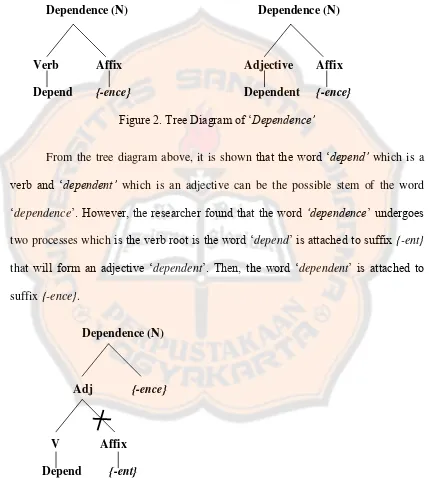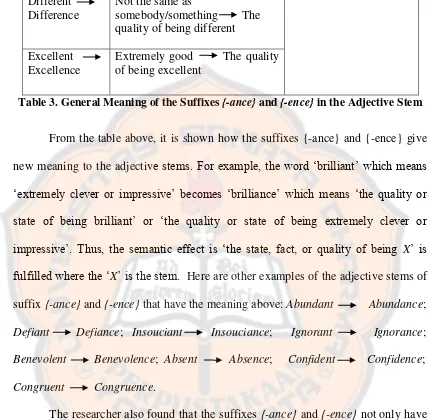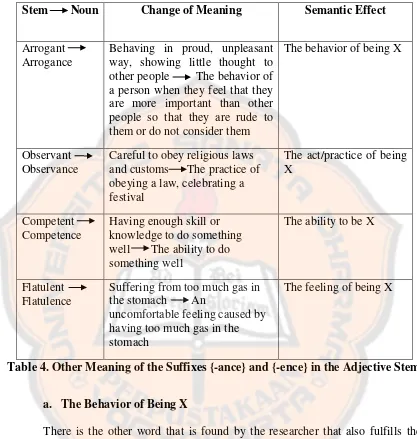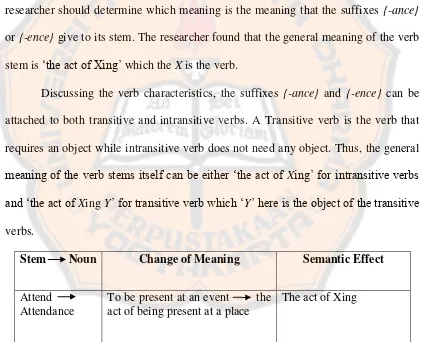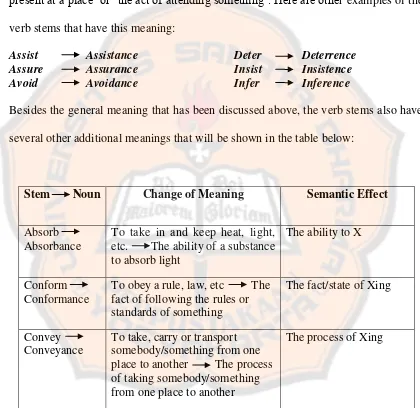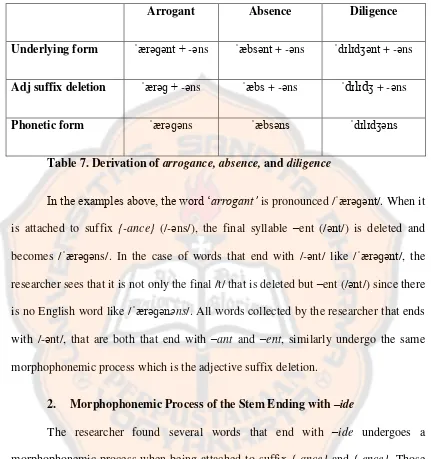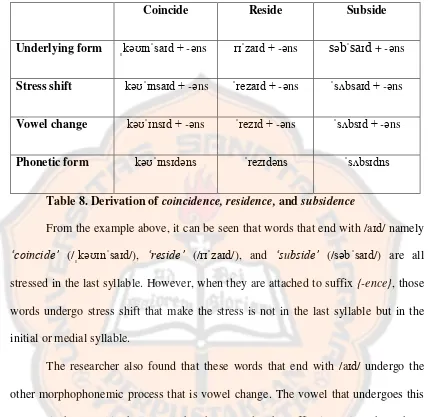i
A MORPHOLOGICAL STUDY OF THE ENGLISH
DERIVATIONAL SUFFIXES {-ENCE} AND {-ANCE}
AN UNDERGRADUATE THESIS
Presented as Partial Fulfillment of the Requirements for the Degree of Sarjana Sastra
in English Letters
By
SAMUEL KRISTIAN
Student Number: 104214027
ENGLISH LETTERS STUDY PROGRAM DEPARTMENT OF ENGLISH LETTERS
FACULTY OF LETTERS SANATA DHARMA UNIVERSITY
ii
A Sarjana Sastra Undergraduate Thesis
A MORPHOLOGICAL STUDY OF THE ENGLISH
DERIVATIONAL SUFFIXES {-ENCE} AND {-ANCE}
By
SAMUEL KRISTIAN
Student Number: 104214027
Approved by
Dr. B. Ria Lestari, M.S. August 29, 2014
Advisor
Dr. Fr. B. Alip, M.Pd, M.A.
August 29, 2014iii
A Sarjana Sastra Undergraduate Thesis
A MORPHOLOGICAL STUDY OF THE ENGLISH
DERIVATIONAL SUFFIXES {-ENCE} AND {-ANCE}
By
SAMUEL KRISTIAN
Student Number: 104214027
Defended before the Board of Examiners on September 26th, 2014
and Declared Acceptable
BOARD OF EXAMINERS
Name Signature
Chairperson : Dr. F. X. Siswadi, M.A.
Secretary : Dra. A. B. Sri Mulyani, M.A., Ph.D. Member 1 : Anna Fitriati, S.Pd., M.Hum.
Member 2 : Dr. B. Ria Lestari, M.Sc. Member 3 : Dr. Fr. B. Alip, M.Pd.,M.A.
Yogyakarta, September 30th, 2014 Faculty of Letters
Sanata Dharma University Dean
iv
STATEMENT OF ORIGINALITY
I certify that this undergraduate thesis contains no material which has been previously submitted for the award of any other degree at any university, and that, to the best of my knowledge, this undergraduate thesis contains no material previously written by any other person except where due reference is made in the text of the undergraduate thesis
Yogyakarta, August 29, 2014
v
LEMBAR PERNYATAAN PERSETUJUAN PUBLIKASI KARYA ILMIAH UNTUK KEPENTINGAN AKADEMIS
Yang bertanda tangan di bawah ini, saya mahasiswa Universitas Sanata Dharma
Nama : Samuel Kristian
Nomor Mahasiswa : 104214027
Demi pengembangan ilmu pengetahuan, saya memberikan kepada Perpustakaan Universitas Sanata Dharma karya ilmiah saya yang berjudul
A MORPHOLOGICAL STUDY OF THE ENGLISH
DERIVATIONAL SUFFIXES {-ENCE} AND {-ANCE}
beserta perangkat yang diperlukan (bila ada). Dengan demikian saya memberikan kepada Perpustakaan Universitas Sanata Dharma hak untuk menyimpan, mengalihkan dalam bentuk media lain, mengelolalnya dalam bentuk pangkalan data, mendistribusikan secara terbatas, dan mempublikasikannya di internet atau media lain untuk kepentingan akademis tanpa perlu meminta ijin kepada saya maupun memberikan royalti kepada saya selama tetap mencantumkan nama saya sebagai penulis.
Demikian pernyataan ini saya buat dengan sebenarnya. Dibuat di Yogyakarta
Pada tanggal 29 Agustus 2014
Yang menyatakan,
vi
vii
For
My Wonderful Mother,
My Cheerful Sister,
My Inspirational Aunt,
and
viii
ACKNOWLEDGEMENTS
I realize that I am only a human that have limitation of strength and knowledge but this thesis is also the best writing I have ever written so far. However, without these people that always help me in the process of writing this thesis, this thesis will not be finished as good as it is.
My greatest thanks go to Jesus Christ, my true savior, for giving me His blessing, knowledge, and wisdom. Thanks for the strength You give me through the hard time.
I would like to say my gratitude to Dr. B. Ria Lestari, M.S. for being my advisor. Thank you for your patience and time for consultation that you have given me during the process of writing my thesis. My gratitude also goes toDr. Fr. B. Alip, M.Pd, M.A. for being my co-advisor who has read my thesis and given me many suggestions and corrections to make my writing better.
I would also like to thank my mother for being my strong mother and for always supporting me through prayer all the time and especially during this thesis writing process. I thank my sister, Mike Kristina, and my aunt as well for everything you have given me that make who I am now.
The last but not least, I would like to thank my girlfriend, Rosalind, for accompanying me in the last two and a half years. Thanks for your cheerfulness that always brings me smile. Thanks for your support through everything that I do.
ix
TABLE OF CONTENTS
TITLE PAGE ... i
APPROVAL PAGE ... ii
ACCEPTANCE PAGE ... iii
STATEMENT OF ORIGINALITY ... iv
LEMBAR PERNYATAAN PERSETUJUAN PUBLIKASI KARYA ILMIAH ... v
MOTTO PAGE ... vi
6. Theory of Morphophonemic Process ... 14
C. Theoretical Framework ... 15
CHAPTER IV: ANALYSIS RESULTS AND DISCUSSIONS ... 21
x
1. Stem of the Suffix {-ance} ... 22
a. Adjective Stem ... 25
b. Verb Stem ... 25
2. Stem of the Suffix {-ence} ... 27
a. Adjective Stem ... 27
b. Verb Stem ... 30
B. Analysis of the Meaning of the Suffixes {-ance} and {-ence} ... 31
1. Adjective Stem ... 32
2. Verb Stem ... 36
C. Morphophonemic Process in the Suffixes {-ance} and {-ence} ... 39
1. Morphophonemic Process of the Adjective Stems Ending with/-ənt/ ... 39
2. Morphophonemic Process of the Stem Ending with –ide ... 40
3. Morphophonemic Process of the Stem Ending with –ur ... 42
4. Morphophonemic Process of the Stem Ending with –er ... 43
5. Morphophonemic Stem of Other Stems ... 47
CHAPTER V: CONCLUSION ... 51
BIBLIOGRAPHY ... 54
xi
LIST OF TABLES
Table 1. Frequency of Stems Based on the Word Class ... 22
Table 2. Occurrence of the Stems by Origin ... 24
Table 3. General Meaning of the Suffix {-ance} and {-ence} in the Adjective Stem ... 32
Table 4. Other Meaning of the Suffixes {-ance} and {-ence} in the Adjective Stem ... 34
Table 5. General Meaning of the Suffixes {-ance} and {-ence} in the Verb Stem ... 36
Table 6. Other Meaning of the Suffixes {-ance} and {-ence} in the Verb Stem 37 Table 7. Derivation of arrogance, absence, and diligence ... 40
Table 8. Derivation of coincidence, residence, and subsidence ... 41
Table 9. Derivation of concurrence, occurrence, and recurrence ... 42
Table 10. Derivation of infer ... 44
Table 11. Derivation of preference and reference ... 45
Table 12. Derivation of enter and remember ... 46
Table 13. Derivation of maintain ... 47
Table 14. Derivation of sustain ... 47
Table 15. Derivation of reverence ... 48
xii
ABSTRACT
KRISTIAN, SAMUEL. A Morphological Study of the English Derivational Suffixes {-ence} and {-ance}. Yogyakarta: Department of English Letters, Faculty of Letters, Sanata Dharma University, 2014.
Language is one important thing for human to communicate with each other. Humans should have knowledge of language in order to make communication successful. However, language is developing each day. For English, there are many processes that show its development. One of the commonest processes of English development is affixation. Affixation is a process of attaching a prefix, suffix, or an infix to the stem. To be specific, suffixation is the commonest among three.
xiii
ABSTRAK
KRISTIAN, SAMUEL. A Morphological Study of the English Derivational Suffixes {-ence} and {-ance}. Yogyakarta: Department of English Letters, Faculty of Letters, Sanata Dharma University, 2014.
Bahasa adalah salah satu hal yang paling penting bagi manusia untuk berkomunikasi dengan orang lain. Kita harus memiliki pengetahuan bahasa supaya sebuah komunikasi dapat berjalan lancar. Namun, bahasa berkembang setiap hari. Dalam Bahasa Inggris, terdapat beberapa proses yang menunjukkan perkembangan tersebut. Salah satu perkembangan dalam Bahasa Inggris yang paling umum adalah afiksasi. Afiksasi adalah sebuah proses penambahan imbuhan, baik awalan, akhiran, atau sisipan ke kata dasar. Lebih spesifik, imbuhan akhiran adalah proses yang paling umum dari tiga proses tersebut.
Penelitian ini membahas tentang akhiran {-ence} dan {-ance} dalam Bahasa Inggris. Pemilihan topik diatas karena akhiran adalah proses yang paling sering terjadi pada kata-kata Bahasa Inggris dan akhiran {-ence} dan {-ance} juga sering digunakan dalam banyak kata Bahasa Inggris. Tiga pokok permasalah dirumuskan dengan tujuan untuk mendapatkan pemahaman yang lebih dalam dari akhiran tersebut: (1) Kata dasar apa saja yang dapat dilekatkan kepada akhiran {-ance} dan {-ence}? (2) Apa makna yang dibawa oleh akhiran {-ance} dan {-ence} setelah dilekatkan kepada kata dasar? (3) Proses morfofonemik apa yang terlibat dalam proses imbuhan akhiran {-ance} dan {-ence} dan apa alomorfnya?
Kamus Oxford Advanced Learner’s Dictionary oleh Hornby digunakan sebagai sumber utama. Semua kata-kata yang dilekatkan pada akhiran {-ance} dan {-ence} dikumpulkan. Setelah mengumpulkan semua data, terdapat 168 kata yang melekat pada kedua akhiran tersebut yang digunakan sebagai data. Kata-kata tersebut dipisahkan menurut kelas kata yang dimiliki dan dianalisa maknanya. Bentuk fonetik dari tiap kata dan kata dasarnya juga dikumpulkan untuk mengetahui proses morfofonemik yang terjadi.
1 CHAPTER I
INTRODUCTION
A. Background of the Study
Language is an important means for humans to communicate with each other. Without it, humans will face difficulties in delivering what they want to say. It means that communication cannot work well and even it will not work without having knowledge of language. However, language does not remain the same all time, meaning that language is developing each day. Some words that exist now may not exist in the past. English itself has also developed from Old English era until now, modern English era. There are many processes that show the development of a language. Some of English vocabulary development is clipping, back formation, acronym, blending, word coining, etc.
In the practice of using English, one of the most common development processes that can be found is affixation. Bauer, in his book Introducing Linguistic Morphology said, “By far, the commonest way of building new words in the languages of the world is by using affixes. The commonest type of affix by far is the suffix.” (Bauer, 2003: 24). P.H. Matthews also stated “In English the commonest
„replay‟ while suffix is an affix that is attached at the end of the stem. For example,
the stem „teach‟ and suffix {-er} will create a new word that is „teacher‟.
Affixation will cause some changes in the stem that is attached to it, that is a change in its word class or a change of meaning. These are known as inflectional and derivational affixes. Robert Beard said,
Unlike inflectional morphology, which specifies the grammatical functions of words in phrases without altering their meaning, derivational morphology or word formation is so named because it usually results in the derivation of a new word with new meaning.
(Spencer, Andrew and Arnold M.Zwicky, 1998: 44)
When an inflectional affix is attached to a word, it will not change the meaning of the stem, while a derivational affix will always change the meaning of the stem attached to it.
B. Problem Formulation
This problem formulation is created in order to get deeper understanding on the chosen topic by the researcher:
1. What stems can be attached to the suffixes {-ance} and {-ence}?
2. What meanings are brought by the suffixes {-ance} and {-ence} after they are attached to the stem?
3. What morphophonemic processes are involved in the affixation of the suffixes {-ance} and {-ence} and what is the allomorph?
C. Objectives of the Study
From the problem formulation that is created by the researcher, there are several objectives to achieve. This study is conducted to analyze the characteristics of the stems that are able to be attached to the suffixes {-ance} and {-ence}. The domain of the analysis is the word class or part of speech of the stem that can be attached to the suffixes {-ance} and {-ence}. This will be useful since the suffixes {-ance} and {-ence} are not always able to be attached to any English words from any word class. The researcher believes that there will be some restrictions occurred in attaching these two suffixes. In the end, the readers will be able to differentiate whether a word can be attached to suffix {-ance} and {-ence} or not.
second objective that will be discussed by the researcher is to find out the meaning that is brought by the suffixes {-ance} and {-ence} to the stems.
The third problem formulation is created in order to know the processes that are involved in attaching the suffixes {-ance} and {-ence} to the stem. Some English words will use suffix {-ance} while others will use suffix {-ence} in the process of suffixation. The researcher wants to find out what morphophonemic processes that are involved in the suffixation of the suffixes {-ance} and {ence} and to know its allomorph. Moreover, some words will undergo some changes in this suffixation. For example, the word “enter” will become “entrance” instead of enterance or enterence when making nominalization. The researcher will also analyze the process of this kind of process.
D. Definition of Terms
1. Definition of Morpheme
“The term morpheme is used to refer to the smallest, indivisible units of semantic content or grammatical functions which words are made up of” (Katamba, 1993: 20).
The word indivisible means that it cannot be divided into separate parts. So, it can be said that morpheme is the smallest linguistic unit that carries a meaning.
2. Definition of Derivational Suffix
Bauer stated, “A derivational affix is one which produces a new lexeme from a base.”
give a new meaning to the stem attached to it but it does not always change its word class. For example, the word „drive‟ which is a verb will become a noun if it is
attached to suffix {-er}, while the word „adventure‟, which is a noun, will remain a noun after attached to suffix {-er}, becomes „adventurer‟
3. Definition of Stem
Stem is defined as “the base to which one or more affixes are attached to create a
more complex form that may be another stem or a word.” (Fromkin, Victoria, Robert
Rodman, and Nina Hyams, 2003: 595). Root is “the morpheme that remains when all affixes are stripped from a complex word.” (Fromkin et al., 2003: 593).
4. Definition of Allomorph
Allomorphs are the “morphs which realize a particular morpheme and which are
conditioned (whether phonetically or lexically or grammatically). (Bauer, 2003:17). In a simpler sentence, allomorph is the variation of a particular morpheme.
5. Definition of Word Class
“One of the classes to which words (more precisely, lexemes) are allocated on the
6. Definition of Morphophonemics
Morphophonemics is defined as “Rules that account for the realization of phonologically conditioned allomorphs of morphemes.” (Katamba, 1993: 34).
7
CHAPTER II
REVIEW OF LITERATURE
In order to get deeper understanding in analyzing the chosen topic, the researcher will review some studies that have been done by other researchers before. The researcher tries to get other studies that have correlation to the topic that the present researcher has chosen. Besides, the review of related theories will also be given in this chapter. Some relevant theories will be reviewed and the present researcher will apply it to the analysis of study.
A. Review of Related Studies
1. Review of Study of Stem Characteristics
were from old English, like band-bandage and foot-footage. The last was the stem which was derived from old Norway language such as bag-baggage.
The difference of this study from the study that was conducted by R.S Kristian Guntur Prasetya lies on the data or object of the study. The present researcher focuses on the suffixes {-ence} and {-ance} while the previous researcher focused on the suffixes {-age} and {-ment}. The study done by previous researcher analyzed the stem characteristic that can be attached to suffix that is being discussed. This is similar with the study by the present researcher, thus it will help the present researcher to have a background of scope of analysis.
2. Review of Study of Meaning and Allomorphs
They are vowel and schwa insertion, vowel and consonant deletion, vowel and consonant change, vowel reduction, and stress shift. The scope of the study conducted by Puspita Maharani was the meaning of allomorphs of the suffix {-cy}.
It is also similar with the topic that will be discussed by the present researcher. The difference of this study from the previous researcher‟s study lies on
the suffix that is going to be analyzed. From the previous study, the present researcher will get a clearer scope in analyzing the meaning and the allomorph of the suffixes {-ance} and {-ence}.
B. Review of Related Theories
In this part, some theories which are going to be used in this study will be reviewed. It is very useful to review some relevant theories in order to give clear understanding in analyzing the topic of the study.
1. Theory of Morpheme
Oxford Advanced Learner’s Dictionary stated that morpheme is the smallest
unit of meaning that a word can be divided into. Merriam Webster Dictionary defines morpheme as a distinctive collocation of phonemes (as the free form pin or the bound form -s of pins) having no smaller meaningful parts. From the two definitions above, it can be concluded that morpheme is the smallest unit that carries a meaning. The word „smallest‟ means it cannot be divided further into any other part. Carstairs and
one word to another. The second is that it contributes in some ways to the meaning of the whole word. The two characteristics above are to allow the meaning of some complex words to be predictable. They emphasized,
Another general point to be made about morphemes is that, although they are the parts out of which words are composed, they do not have to be of any particular length.
(Carstairs et al., 2002: 17)
Morphemes are categorized into two. Those are free morphemes and bound morphemes. A free morpheme is a morpheme that can stand by itself. It means it does not have to be attached to other morpheme. For example „teach‟ is a free morpheme since it carries a lexical meaning and it does not have to be attached to other morpheme to be meaningful. A bound morpheme is a morpheme that has to be attached to other morpheme so that it can bring a meaning. For example, the suffix „{-er}‟ is a bound morpheme since it does not have meaning if it stands alone (without being attached to other morpheme).
Akmajian in his book, Linguistics: An Introduction to Language and Communication gave a figure of morpheme:
MORPHEME
FREE BOUND
INDEPENDENT WORDS PREFIXES SUFFIXES
Figure 1. A basic classification of morphemes
There is also a less common process in English namely infix which a process of attaching an affix in the middle of a word, such as in the word „speedometer‟. The
„o‟ in there is an infix.
2. Theory of Derivational Affix
In word formation, affixation is one of the most common processes that are used by people. An affix itself is defined as “a morpheme which only occurs when attached to some other morpheme.” (Katamba: 1993,44). It means that an affix is
always a bound morpheme. Szymanek defines affixation as ”the combination of a bound (derivational or inflectional) morpheme with a stem or root.” (Szymanek,
1989: 62).
Affixes are categorized into two, which are inflectional and derivational. Bauer said, “An inflectional affix is one which produces a new word-form of a
lexeme from a base. A derivational affix is one which produces a new lexeme from a base.” The term inflectional has meaning that it does not change the word class of the
with the same meaning of the stem. It will just give information of plural noun. The derivational affix, as stated above, will give a new meaning to the stem. For example, the derivational suffix {-er} is attached to the verb „teach‟ will change the meaning of the stem into „someone who teach‟. The derivational suffix {-er} changes the word class and the meaning of the stem.
3. Theory of Meaning
Meaning is one of several fields to analyze in linguistic study. A communication will succeed if the speakers understand the meaning of words, phrases, and sentences that they say. The study of meaning is called semantics. ”The
study of the linguistic meaning of morphemes, words, phrases, and sentence is called
semantics.” (Fromkin et.al., 2003: 173). The basic way to know the meaning of a
4. Theory of Allomorph
An allomorph is one segment that is used in this study. An allomorph is said as different morphs represent the same phoneme. The way to identify whether a morphs is an allomorph of the same morpheme is if they are in complementary distribution.
Morphs are said to be in complementary distribution if they represent the same meaning or serve the same grammatical function and they are never found in identical context. (Katamba, 1993:27)
Katamba explains that sometimes different morphs may represent the same morpheme (Katamba, 1993: 25). He gave an example of the past tense of regular verbs in English which is spelled –ed is realized in speech by /Id/, /d/ or /t/.
choice of allomorph –en depends on the presence of specific noun ox. Suppletion is when allomorphs of a morpheme are not phonetically related. For example, good and better represent the same lexeme good.
5. Theory of Word Class
Word class is usually called as part of speech. A suffix usually will affect the word class of the base attached to it. There are two terms which are used to indicate it. They are class-changing and class-maintaining. Class-maintaining is a situation which the base is still in its previous word class after it is attached to some suffixes while class-changing is a situation in which a new word class is formed after the base is attached to suffix. “What I have just called word classes are the same as what in
traditional terminology are called part of speech.”. (Carstairs and McCarthy, 2002:
45).
6. Theory of Morphophonemic Process
Katamba defined morphophonemic process as “rules that account for the realization of phonologically conditioned allomorphs of morphemes.” (Katamba,
1993: 34). Thus, morphophonemic process will discuss the phonological change that occurs in morphemes.
Wolfram and Johnson elaborated several kinds of processes. The first one is assimilation. Assimilation is a process “in which a sound takes on the characteristics
attached to word that the initial sound is bilabial. The second is dissimilation. This term refers to the “process in which segments change to become less like a
neighboring segment. However they also stated that this process is not common in English. (Wolfram and Johnson, 1982: 93). The third is the deletion rule. In this rule, unit which occur in some contexts are lost in others. The example of this process of this rule is the form ‘he will’ (/ hi wɪl/) becomes ‘he’ll’ (/hiːl/). Epenthesis or insertion is a process of adding a segment. The example is inserting [p] in the medial syllable of the word „comfort‟ [ˈkʌmpfət ]. (Wolfram and Johnson, 1982: 98). Methathesis rule is “when two segments reverse positions.” The example is /prəˈnaʊns/ becomes
/pərˈnaʊns/ in the word ‘pronounce’. Stress shift is the term that is used when the stressing of a word shifts to other syllable. Vowel change is the process of changing a vowel into another vowel of a word while consonant change is the process of changing a consonant into another consonant of a word after undergone a process.
C. Theoretical Framework
The researcher uses six theories to be the guideline in conducting this study, those are: theory of morpheme, theory of derivational affix, theory of meaning, theory of allomorph, theory of word class and theory of verb categories.
researcher clear understanding of the meaning of morpheme and how it is used in this study to reach the intended goal. The second, theory of word class will directly give the researcher the word class of a word in order to answer the first problem formulation that is to know the word class of the data that can be attached to the suffixes {-ance} and {-ence}.
To answer the second problem formulation that is what meaning brought by the suffixes {-ance} and {-ence} after they are attached to the stem, theory of meaning and theory of derivational affix is used. The researcher uses the theory of meaning to find out the meaning of the suffixes {-ance} and {-ence} and how it affects the stems attached to it. Theory of derivational affix is used to show that the suffixes {-ance} and {-ence} give new meaning to the stems which is the characteristic of the derivational affix.
17
CHAPTER III
METHODOLOGY
In this chapter, the researcher will elaborate the methodology that is used to conduct this study. This methodology is very important since it will help the researcher conduct the study systematically according to the method. This chapter is divided into three parts. The first part is the object of the study which contains the data and the source of the data that is used in this study. The second part is the approach of the study which contains how the approach chosen is used in this study. The last part is the method of the study which contains the process of collecting data that is used and the steps of analysis that are used in order to be able to answer the problem formulations.
A. Object of the Study
B. Approach of the Study
The researcher uses morphological and phonological approaches to analyze the data. Morphology is the study of word structure. While a morpheme, as mentioned above, is the smallest unit that carries a meaning. A morphological approach is suitable to answer the first problem formulation since the object of this study is morphemes and how a morpheme is related to each other.
The semantic approach is used to answer the second problem formulation which is to find the meaning of the suffixes to the stems. The third approach is the morphophonemic approach. Morphophonemic approach is related to the phonological change to a particular morpheme after it undergoes morphological process. This is used to answer the third problem formulation that is to find the process that is involved in suffixation of {-ance} and {-ence} to the stems and to find its allomorph.
C. Method of the Study
This part is divided into two sub parts which are: data collection that contains the process of collecting the data and data analysis that elaborates the steps that are used to analyze the data.
1. Data Collection
different parts. Besides, the researcher also collected the phonetic transcription of every word that was found in the dictionary, the stem of each words and its phonetic transcription as well.
It was found then that not all alphabet initials in OALD have words that are attached to suffix {-ance} and {-ence}. After listing all the data, it was found that there are 183 words that ends with either the suffix {-ance} or {-ence}.
2. Data Analysis
There were several steps that were taken to analyze the data that were already collected. The first step was to collect the data from the source that is OALD. The data, as mentioned above, were all words that are attached to the suffixes {-ance} and {-ence}. Not only collecting the words, the researcher also listed the stem of each word, the meaning and wrote down the phonetic transcriptions.
here means the word class of the stems that are attached to the suffixes {-ance} and {-ence}.
To answer the second problem formulation, the researcher had listed all the words that are attached to the suffixes {-ance} and {-ence} and the stems of every word that are found. The researcher collected the meaning of the stems that are found in OALD. From it, the researcher would be able to determine the meaning of word ends with the suffixes {-ance} and {-ence}.
21
CHAPTER IV
ANALYSIS RESULTS AND DISCUSSIONS
This chapter contains the result of the finding that has been done by the researcher which is the result of the data collection and the analysis of the data. At the end of the data collection, the researcher found one hundred and eighty three words that are attached to either the suffix {-ance} or the suffix {-ence}. The words that end with either -ance or –ence but not as suffix such as grievance, audience, influence, and sentence, are not included to the data that were collected by the researcher.
A. Analysis of Word Class of the Stem Receiving the Suffixes {-ance} and
{-ence}
1. Stem of the Suffix {-ance}
In this part, the researcher will discuss about the word class of the stems that are able to be attached to the suffixes {-ance} and {-ence}. From the data that are found, there are only two word classes of the stems that can be attached to the suffixes {-ance} and {-ence}. Those are adjective and verb. The table below will show the numbers of words and stems that are able to be attached to the suffixes {-ance} and {-ence}.
No. Suffix Stem Number of Occurrence
1. {-ance}
Adjective 32
Verb 38
2. {-ence}
Adjective 65
Verb 33
TOTAL 168
Table 1. Frequency of Stems Based on the Word Class
what Szymanek said that “..-ance and –ence are clearly related to another which typically combine with adjectives rather than verbs.” (Szymanek, 1989:149).
The researcher found that there are several words that belong to more than one word class. For example, the word „assistance‟ comes from word „assist‟ which has
more than one word classes that are verb and noun. In this case, the researcher should determine whether the stem of the word „assistance‟ is the verb or the noun. Thus, the researcher uses some considerations. First, the researcher will refer to the commonest stem of the suffixes {-ance} and {-ence}. From the data that has been collected, the researcher found that the stem that is more common for the suffixes {-ance} and {-ence} is adjective. This is also strengthened by Szymanek in his book Introduction to Morphological Analysis. He said, “..-ance and –ence are clearly related to another which typically combine with adjectives rather than verbs.” (Szymanek, 1989:149). Secondly, the consideration that is taken by the researcher is by analyzing the meaning of the word. According to OALD, the word „assist‟ as noun has meaning „an action in hockey, baseball, etc. in which a player helps another player on the same team to score a goal or point while „assist‟ as verb means to help somebody to do
something. Referring to the function of the suffixes {-ance} and {-ence} which is the state or fact of the stem (later will be mentioned as state/fact of X), the researcher found that the most suitable stem of the word „assistance‟ is the word „assist‟ as a
From the data that is collected by the researcher, it is found that almost all of the words that can be attached to the suffixes {-ance} and {-ence} are derived from Latin. Only few of the data are derived from other origins such as French, Germanic, and Old English. The table below will show the occurrence of the base that can be attached to suffix {-ance} and {-ence} which are sorted by its origins.
Suffix Word Class
Number of Occurrence by Base Origin Sub
Total Latin French Germanic Old English
{-ance} Adjective 29 3 0 0 32
Verb 34 2 1 1 38
{-ence} Adjective 65 0 0 0 65
Verb 33 0 0 0 33
TOTAL 168
Table 2. Occurrence of the Stems by Origin
a. Adjective Stem
There are some characteristics of adjective stems that can be attached to the suffixes {-ance} and {-ence}. Most of adjective stems that can be attached to the suffixes {-ance} and {-ence} are derived from Latin words.
Most of them end with -ant. There are thirty words that end with -ant are derived from Latin. Some of them are:
Abundant Abundance Ignorant Ignorance Arrogant Arrogance Important Importance Brilliant Brilliance Luxuriant Luxuriance Consonant Consonance Petulant Petulance
Dominant Dominance Reliant Reliance
There are also found few adjective stems of suffix {-ance} that are derived from other origins such as from French:
Defiant Defiance Flamboyant Flamboyance Insouciant Insouciance
b. Verb Stem
Here are some verb stems that are derived from Latin word:
Absorb Absorbance Comply Compliance
Appear Appearance Continue Continuance
Assist Assistance Disturb Disturbance
Assure Assurance Endure Endurance
Attend Attendance Inherit Inheritance
According to Szymanek, there is one phenomenon in derivational morphology in which the verb is involved. It is called as Nomina Actionis. He elaborated that Nomina Actionis is “means and methods available in English derivational
morphology for conveying the nominal concept „act(ion)/process of V-ing”. (Szymanek, 1989: 135). Related to the study of the researcher, suffix {-ance} can be included as Nomina Actionis since one word class that is the stem of the suffix {-ance} is verb and the function of it is forming noun.
Two words derived from French are found by the researcher. These two verbs are dally dalliance; and perform performance. There is also one word that is derived from Germanic that is guide guidance and one word from Old English that is utter utterance.
There are some characteristics of verb stems of suffix {-ance}. From the data collection, the researcher found that several of the verbs stems of the suffix {-ance} has characteristic of end with –y, -ure, and –ear. The verb stems that end with –y, -are, and -ure has a rule when attached to suffix {-ance}.
The verbs that are found by the researcher are: annoy annoyance, and convey conveyance. However, the researcher also found that when a verb stem ends with –y and is preceded by a consonant, the –y ending is changed into –i before being attached to the suffix {-ance}. The verb stems that fulfill this characteristic are: ally alliance, comply compliance, and dally dalliance.
There are two verbs that end with –ear and are derived from Latin word. Those two words are: appear appearance and clear clearance. From the data collection, there are verb stems that end with –ure, –ue, and –e. These verb stems undergo a change when it is attached to suffix {-ance}. When verb stems ends with final –e, the final –e is removed before it is attached to suffix {-ance}.
Assure Assurance Persevere Perseverance Continue Continuance Pursue Pursuance Endure Endurance Resemble Resemblance
Guide Guidance
2. Stem of the Suffix {-ence}
Suffix {-ence} that has a similar function with suffix {-ance} is also one suffix that is analyzed by the researcher in this study. From the data collection, suffix {-ence} also shares the same stems. The suffix {-ence} can be attached to either adjectives or nouns.
a. Adjective Stem
derived from Latin words. There is a characteristic of the adjective stems of suffix {-ence} that they ends with –ent. Here are some words that the researcher found:
Absent Absence Diffident Diffidence
Belligerent Belligerence Eloquent Eloquence
Confident Confidence Innocent Innocence
Congruent Congruence Opulent Opulence
Consequent Consequence Permanent Permanence In analyzing the adjective stems of the suffix {-ence}, the researcher found that there are some cases when two word classes of a word are suitable as the stem. Referring to the function of suffix {-ence} and {-ance} which is the state/fact of X or an act of Xing, the researcher found more than one possible stems of one word that fulfill the functions of suffix {-ence}. For example, the word „dependence’ has two possible stems that are the verb „depend’ and the adjective „dependent’. This phenomenon is also similar with what Szymanek mentioned as parallel (double) motivation (Szymanek, 1989: 130).
word classes to be the suffix of one word that, in this case, is the word „dependence‟. The process will be shown through the tree diagram below.
Dependence (N) Dependence (N)
Verb Affix Adjective Affix
Depend {-ence} Dependent {-ence}
Figure 2. Tree Diagram of „Dependence’
From the tree diagram above, it is shown that the word „depend’ which is a verb and „dependent’ which is an adjective can be the possible stem of the word „dependence‟. However, the researcher found that the word ‘dependence‟ undergoes two processes which is the verb root is the word „depend‟ is attached to suffix {-ent} that will form an adjective „dependent‟. Then, the word „dependent‟ is attached to suffix {-ence}.
Dependence (N)
Adj {-ence}
V Affix
Depend {-ent}
From the tree diagram above, the researcher found the process of nominalization of the word „dependence‟ passes two processes which is from the root verb „depend’ and the stem „dependent‟. Thus, the researcher concludes that it is inefficient and not economical if the stem of the word „’dependence‟ is the adjective „dependent‟ since people should knock off the adjective suffix -ent. For the sake of economical principle, the researcher decides that the stem of the word ‘dependence’ is the verb „depend‟. There are also several other words that have the same problem that are found by the researcher. Those are: Abhorrent Abhorrence; Acquiescent Acquiescence; Different Difference; Divergent Divergence; Existent Existence; Obedient Obedience. The researcher also adds cross mark in the tree diagram above that indicates the deletion of the final –ent of the adjective stems before being attached to suffix {-ence}.
b. Verb Stem
Verb is also one word class that can be attached to suffix {-ence}. The researcher found thirty three verbs that are the stem of suffix {-ence}. From there, the researcher found that all verbs that are the stem of suffix {-ence} are derived from Latin word.
Concur /kənˈkɜː(r)/ Concurrence Deter /dɪˈtɜː(r)/ Deterrence Infer /ɪnˈfɜː(r)/ Inference Occur /əˈkɜː(r)/ Occurrence Prefer /prɪˈfɜː(r)/ Preference Recur /rɪˈkɜː(r)/ Recurrence Refer /rɪˈfɜː(r)/ Reference
There are other characteristics of the verb stem of suffix {-ence} that several of them end with –ere. Here are some verbs that are found by the researcher: Adhere
Adherence; Cohere Coherence; Interfere Interference; Revere
Reverence. Other verb stems that are found end with –sce ending such as: Convalesce Convalescence; Deliquesce Deliquescence; Recrudesce Recrudescence; and Reminisce Reminiscence.
B. Analysis of the Meaning of the Suffixes {-ance} and {-ence}
In this part, the researcher will elaborate the analysis of the meaning that is brought by the suffixes {-ance} and {-ence} to the stems. As discussed above, the suffixes {-ance} and {-ence} has function of nominalization which means it will form a noun to the stem to which it is attached. Since the suffixes {-ance} and {-ence} are categorized as derivational suffix, they will also give a new meaning to the stems which is attached to it.
meaning. Generally, both suffix {-ance} and {-ence} bring meaning of „the state/fact of‟. Thus, the researcher will not divide the elaboration of this part by the suffixes
which are {-ance} and {-ence} but only by the word class of the stems.
In this analysis, the researcher will elaborate the meaning of the stems and how they undergo change of meaning after being attached to the suffixes {-ance} and {-ence}.
1. Adjective Stem
As the main source of the analysis, the researcher uses OALD. From it, the researcher found that the suffixes {-ance} and {-ence} have meaning of „the state/fact of‟. The researcher found that all adjective stems that are collected by the researcher
fulfill the criteria of the meaning that is stated in the dictionary. Adjective stems are the most productive stem of the suffixes {-ance} and {-ence} according to the data that is collected by the researcher. Here are several examples of the adjective stem with the change of meaning after being attached to the suffixes {-ance} and {-ence}:
Stem Noun Change of Meaning Semantic Effect
Different Difference
Not the same as
somebody/something The quality of being different Excellent
Excellence
Extremely good The quality of being excellent
Table 3. General Meaning of the Suffixes {-ance} and {-ence} in the Adjective Stem
From the table above, it is shown how the suffixes {-ance} and {-ence} give new meaning to the adjective stems. For example, the word „brilliant‟ which means „extremely clever or impressive‟ becomes „brilliance‟ which means „the quality or
state of being brilliant‟ or „the quality or state of being extremely clever or
impressive‟. Thus, the semantic effect is „the state, fact, or quality of being X‟ is fulfilled where the „X‟ is the stem. Here are other examples of the adjective stems of suffix {-ance} and {-ence} that have the meaning above: Abundant Abundance; Defiant Defiance; Insouciant Insouciance; Ignorant Ignorance; Benevolent Benevolence; Absent Absence; Confident Confidence; Congruent Congruence.
The researcher also found that the suffixes {-ance} and {-ence} not only have meaning of „the state/fact of‟ but it also gives several additional meanings to the
Stem Noun Change of Meaning Semantic Effect
Arrogant Arrogance
Behaving in proud, unpleasant way, showing little thought to other people The behavior of a person when they feel that they are more important than other
Table 4. Other Meaning of the Suffixes {-ance} and {-ence} in the Adjective Stem
a. The Behavior of Being X
There is the other word that is found by the researcher that also fulfills the meaning of „the behavior of being X‟ that is: Decadent Decadence.
b.The Act/Practice of being X
„the practice of being observant‟ or „the practice of obeying a law, celebrating a festival.” Here are other words that also have this meaning:
Defiant Defiance Divergent Divergence
Temperate Temperance Grandiloquent Grandiloquence Extravagant Extravagance Irreverent Irreverence
c. The Ability to be X
There are several words that are found by the researcher that have this meaning. The example in the table above is „competent‟ which means „the ability to be competent‟ or „the ability to do something well.‟ Other examples of words that have the meaning of „the abilityto be X‟ are:
Tolerant Tolerance Patient Patience
Competent Competence Prescient Prescience
Eloquent Eloquence Resilient Resilience
Intelligent Intelligence
d. The Feeling of Being X
The researcher only found two words that have this meaning, that are: Flatulent Flatulence and Penitent Penitence.
From the additional meanings of the adjective stems above, the researcher saw that the additional meanings of the suffixes {-ance} and {-ence} are still related or similar to the general meaning which is „the state/fact of‟. For example, a word that has meaning of „the ability to be X‟ such as „tolerance‟ means „the ability of being
word „tolerance‟ emphasizes the ability, not only the fact of being tolerant in that
particular time.
2. Verb Stem
Verb stem is the second word class that can be attached to the suffixes {-ance} and {-ence}. In the process of attaching the verb stem to the suffix, there are some considerations to take. Firstly, some verbs have more than one meaning however the researcher should determine which meaning is the meaning that the suffixes {-ance} or {-ence} give to its stem. The researcher found that the general meaning of the verb stem is „the act of Xing‟ which the X is the verb.
Discussing the verb characteristics, the suffixes {-ance} and {-ence} can be attached to both transitive and intransitive verbs. A Transitive verb is the verb that requires an object while intransitive verb does not need any object. Thus, the general meaning of the verb stems itself can be either „the act of Xing‟ for intransitive verbs and „the act of Xing Y‟ for transitive verb which „Y‟ here is the object of the transitive verbs.
Stem Noun Change of Meaning Semantic Effect
Attend Attendance
To be present at an event the act of being present at a place
The act of Xing
As discussed above, the general meaning of the verb stem + {-ance}/{-ence} is „the act of Xing‟. For example, „attend‟ means „to be present at an event‟ becomes
„attendance‟ when it is attached to suffix {-ance} which means „the act of being present at a place‟ or „the act of attending something‟. Here are other examples of the
verb stems that have this meaning:
Assist Assistance Deter Deterrence
Assure Assurance Insist Insistence
Avoid Avoidance Infer Inference
Besides the general meaning that has been discussed above, the verb stems also have several other additional meanings that will be shown in the table below:
Stem Noun Change of Meaning Semantic Effect
Absorb
a. The Ability to X
The example above is „absorb‟ which means „to take in and keep heat, light, etc.‟ is attached to suffix {-ance} becomes „the ability of a substance to absorb light‟ or „the ability to absorb‟. The researcher found that only two verb stems that have this
meaning. The other one is: Endure Endurance.
b. The fact/state of Xing
The word „conform‟ means „to obey a rule, law, etc.‟. It is attached to suffix
{-ance} becomes „conformance‟ which means „the fact of conforming‟ or „the fact of following the rules or standards of something.‟ Here are other examples of words
with this meaning:
Appear Appearance Concur Concurrence Inherit Inheritance
Cohere Coherence Continue Continuance Emerge Emergence
Coincide Coincidence Deliver Deliverance
c. The process of Xing
The idea of this meaning is not only an act but it emphasizes the process of doing the verb. One example is the word „convey‟ means „to take, carry or transport somebody/something from one place to another‟becomes „conveyance‟ which means
„the process of taking somebody/something from one place to another‟ or „the process
of conveying‟. There is the other word that has this meaning that is Convalesce Convalescence.
electricity to pass along or through it‟. After being attached to suffix {-ance}, it becomes „the degree to which an object allows electricity or heat to pass through it.‟
The semantic effect of this meaning is uncommon that is „the degree of something to
X‟ which the X is a verb stem.
C. Morphophonemic Process in the Suffixes {-ance} and {-ence}
In this part, the researcher will discuss about the morphophonemic processes that are involved in attaching the suffixes {-ance} and {-ence}.
Most of the adjective stems that have been collected shows that they end with either –ant or –ent (/-ənt/).
1. Morphophonemic Process of the Adjective Stems Ending with /-ənt/
The researcher found one hundred and two adjective stems that end with /-ənt/. The words that end with either –ant and –ent are similarly pronounced as /-ənt/ therefore the analysis of the words that ends with –ant and –ent will not be separated. For adjective stems ending with –ant or –ent, the morphophonemic process requires the deletion of the adjective suffixes –ant or –ent before the affixation with {-ance} or {ence} for the base. Since both suffix {-ance} and {-ence} are pronounced as /-əns/, the analysis of it will not be separated in this part.
Arrogant Absence Diligence
Underlying form ˈærəɡənt + -əns ˈæbsənt + -əns ˈdɪlɪdʒənt + -əns
Adj suffix deletion ˈærəɡ + -əns ˈæbs + -əns ˈdɪlɪdʒ + -əns
Phonetic form ˈærəɡəns ˈæbsəns ˈdɪlɪdʒəns
Table 7. Derivation of arrogance, absence, and diligence
In the examples above, the word „arrogant’ is pronounced /ˈærəɡənt/. When it
is attached to suffix {-ance} (/-əns/), the final syllable –ent (/ənt/) is deleted and becomes /ˈærəɡəns/. In the case of words that end with /-ənt/ like /ˈærəɡənt/, the researcher sees that it is not only the final /t/ that is deleted but –ent (/ənt/) since there is no English word like /ˈærəɡənəns/. All words collected by the researcher that ends with /-ənt/, that are both that end with –ant and –ent, similarly undergo the same morphophonemic process which is the adjective suffix deletion.
2. Morphophonemic Process of the Stem Ending with –ide
Coincide Reside Subside
Underlying form ˌkəʊɪnˈsaɪd + -əns rɪˈzaɪd + -əns səbˈsaɪd + -əns
Stress shift kəʊˈɪnsaɪd + -əns ˈrezaɪd + -əns ˈsʌbsaɪd + -əns
Vowel change kəʊˈɪnsɪd + -əns ˈrezɪd + -əns ˈsʌbsɪd + -əns
Phonetic form kəʊˈɪnsɪdəns ˈrezɪdəns ˈsʌbsɪdns
Table 8. Derivation of coincidence, residence, and subsidence
From the example above, it can be seen that words that end with /aɪd/ namely ‘coincide’ (/ˌkəʊɪnˈsaɪd/), ‘reside’ (/rɪˈzaɪd/), and ‘subside’ (/səbˈsaɪd/) are all
stressed in the last syllable. However, when they are attached to suffix {-ence}, those words undergo stress shift that make the stress is not in the last syllable but in the initial or medial syllable.
The researcher also found that these words that end with /aɪd/ undergo the other morphophonemic process that is vowel change. The vowel that undergoes this process is the vowel in the last syllable that precedes the suffix {-ence}. In these three words that are found by the researcher, the vowel is /aɪ/ and is change into /ɪ/ when being attached to suffix {-ence} /əns/. The word ‘coincide’, for example, is pronounced /ˌkəʊɪnˈsaɪd/. When it is attached to /əns/, the vowel undergoes a change and becomes /kəʊˈɪnsɪdəns/ instead of /kəʊˈɪnsaɪdəns/.
vowel change as the researcher discussed earlier. However, the second possibility does. Without disregarding the first possibility of pronunciation of ‘subsidence’, the researcher still includes the word since there are other words that undergo the same process and it is predictable.
3. Morphophonemic Process of the Stem Ending with –ur
Several words that end with –ur are found by the researcher and undergoes a morphophonemic process which is vowel change. There are three words that are found by the researcher namely concurrence, occurrence, and recurrence.
Concur Occur Recur
Underlying form kənˈkɜː(r) + -əns əˈkɜː(r) + -əns rɪˈkɜː(r) + -əns
Vowel change kənˈkʌr + -əns əˈkʌr + -əns rɪˈkʌr + -əns
Phonetic form kənˈkʌrəns əˈkʌrəns rɪˈkʌrəns
Table 9. Derivation of concurrence, occurrence, and recurrence
In the case of spelling, the researcher also found that when a word ends with -r and is preceded by a vowel, the ending –r is doubled as long as there is a consonant before the vowel when it is attached to suffix {-ence}. As seen above that the sound that precedes the vowel in the examples is /k/. Thus, the ending –r is doubled becomes concurrence, occurrence, and recurrence.
The same process is not found when there is a fricative sound precedes the vowel of a word ending with –r. There are four stems that are found by the researcher which show this process namely deliver, infer, prefer, and refer.
These –r endings still remain single when it is attached to suffix {-ance} or {-ence}: Deliver Deliverance, Infer Inference, Prefer Preference, and Refer
Reference.
4. Morphophonemic Process of the Stem Ending with -er
attached to suffix {-ence} becomes ‘deterrence’ since the sound that precedes the vowel of the last syllable is consonant /t/.
Besides, there is other process that undergoes in infer, prefer, and refer:
Infer
Underlying Form ɪnˈfɜː(r) + -əns
Stress shift ˈɪnfɜː(r) + -əns
Vowel change ˈɪnfə:(r) + -əns
Phonetic form ˈɪnfərəns
Table 10. Derivation of infer
The word „infer‟ undergoes two processes namely stress shift and vowel change. The stem „infer‟ is stressed in the last syllable. The stressing moves to the initial syllable when being attached to suffix {-ence}. The other process that occurs in this stem is a vowel change from /ɜ/ to /ə/. It is seen in the vowel of the syllable preceding the suffix {-ence} is /ɜ/ and it is changed to /ə/ after the suffixation.
The other two words, prefer and refer, also undergoes the same process with ‘infer‟. However, the researcher found that these two stem undergoes additional
Prefer Refer
Underlying form prɪˈfɜː(r) + -əns rɪˈfɜː(r) + -əns
Stress shift ˈprɪfɜː(r) + -əns ˈrɪfɜː(r) + -əns
Vowel change ˈprɪfə:(r) + -əns ˈrɪfə:(r) + -əns
Vowel change ˈprefər + -əns ˈrefər + -əns
Vowel Deletion ˈprefr + -əns ˈrefr + -əns
Phonetic form ˈprefrəns ˈrefrəns
Table 11. Derivation of preference and reference
The data above shows that there is a stress shift of the stems. Like in /prɪˈfɜː(r)/, the stress is in the last syllable. It is then shifted to the initial syllable
when suffixation takes place. There is a vowel change when it is attached to suffix that is vowel /ɪ/ changes to /e/ in the initial syllable. The researcher also found that the vowel of the syllable preceding the suffix is deleted. As seen above, /prɪˈfɜː(r)/ becomes /ˈprefrəns/. However, the researcher believes that before the vowel is deleted, there is a vowel change process takes place that is the vowel /ɜ/ to /ə/ since other data namely the word „infer‟ undergoes a vowel change when suffixation process occurs.
morphophonemic process. However, the stems enter and remember are found to undergo a process.
Enter Remember
Underlying Form ˈentə(r) + -əns rɪˈmembə(r) + -əns
Vowel Deletion ˈentr + əns rɪˈmembr + əns
Phonetic Form ˈentrəns rɪˈmembrəns
Table 12. Derivation of enter and remember
5. Morphophonemic Process of Other Stems
In this part, the researcher analyzes the morphophonemic process of stems with miscellaneous ending that is different from those that have been analyzed above. The morphophonemic process that is undergone also varies in these stems. The stems that are discussed here are the verb stems that have not been discussed above by the researcher.
The verb stems namely maintain, and sustain undergoes a morphophonemic process that is vowel change and stress shift.
Maintain
Underlying form meɪnˈteɪn + -əns
Stress shift ˈmeɪnteɪn + -əns
Vowel change ˈmeɪntən + -əns
Phonetic form ˈmeɪntənəns
Table 13. Derivation of maintain
The verb stem sustain even undergoes vowel change in the first and last syllable.
Sustain
Underlying form səˈsteɪn + -əns
Stress shift ˈsəsteɪn + -əns
Vowel change ˈsʌsteɪn + -əns
Vowel change ˈsʌstən + -əns
Phonetic form ˈsʌstənəns
The verb stems that end with final –e undergoes zero morphophonemic process. However, there are a change in the spelling that is the final –e is deleted before being attached to suffix {-ence}. Here are the verb stems that undergo this process:
Adhere Adherence Indulge Indulgence Cohere Coherence Interfere Interference Convalesce Convalescence Recrudesce Recrudescence Deliquesce Deliquescence Reminisce Reminisce Emerge Emergence Revere Reverence
However, there is an exception for the last verb stem above that is „revere’ since it undergoes a morphophonemic process that is a vowel change, and stress shift.
Revere
Underlying form rɪˈvɪə(r)+ -əns
Stress shift ˈrɪvɪə(r) + -əns
Vowel change ˈrevɪə(r) + -əns
Vowel change ˈrevə(r) + -əns
Phonetic form ˈrevərəns
Table 15. Derivation of reverence
Verb stems that end with –y also undergo a process when being attached to the suffix. The verb stems that end with –y and are preceded by a consonant will change its final –y to –i when being attached to the suffix.
However, there is no change in spelling when the verb stems end with –y and are preceded by vowel, such as:
Annoy Annoyance Convey Conveyance
Some other verb stems also undergoes zero process and directly be attached to the suffixes {-ance} and {-ence}. Those are the verbs that end with –ist such as assist, insist, persist, and subsist.
From the data that has been collected, the researcher found that the suffix {-ence} is more dominant in the case of occurrence than the suffix {-ance}.
No Suffix Number of Occurrence Percentage
1. {ance} 70 42%
2. {-ence} 98 58%
TOTAL 168 100%
Table 16. Percentage of Occurrence of the Suffixes {-ance} and {-ence}
51
CHAPTER V
CONCLUSION
The researcher has discussed the morphological structure of the suffixes {-ance} and {-ence}. The researcher has collected one hundred and sixty eight words as the data of this study with the division of ninety seven adjectives and seventy one verbs are attached to the suffixes {-ance} and {-ence}. From the analysis, the first problem is answered that both suffix {-ance} and {-ence} has function to form noun from adjectives and verbs. It means, the suffixes {-ance} and {-ence} can only be attached to adjective and verb stems. The stems of these suffixes are mostly the adjectives rather than verbs. There are some characteristics of the stems of these suffixes. The adjective stems of the suffix {ance} mostly end with –ant while most of the suffix {-ence} has adjective stems that end with –ent. In the process of affixation, when the adjective stems end with either –ant or –ent, the morphophonemic process requires the deletion of the adjective suffix –ant or –ent before being attached to the suffixes {-ance} and {-ence}. For the verb stems, the suffix {-ance} are mostly attached to verbs that end with –y, -ure, and –ear and the suffix {-ence} will be attached to verbs that end with –ur, -ere, and –sce. The verb stems of these suffixes are found to be either transitive or intransitive verbs.
and {-ence} to the stems. The suffixes {-ance} and {-ence} are involved to derivational suffix that will always change the meaning of the stems that are attached to it. In analyzing the meaning of these suffixes, the researched did not divide each of these suffixes since both shares the same meaning and role. Both have general meanings which are „the state/fact of being X‟ or „the act of Xing‟. Besides, these suffixes also produce other additional meaning such as „the behavior of being X‟, „the ability to be X‟, and „the feeling of being X‟ that are found attached to adjective stems and „the process of Xing‟ which is attached to verb stems. From its meaning, it is known that both suffix {-ance} and {-ence} form uncountable nouns.
BIBLIOGRAPHY
Akmajian, Adrian, Richard A. Demers, and Robert M.Harnish. “Linguistics: An Introduction to Language and Communication (Second Edition)”. Cambridge: The MIT Press, 1984.
Bauer, Laurie. “Introducing Linguistic Morphology (Second Edition)”. Washington, D.C.: Georgetown University Press, 2003.
Carstairs, Andrew, McCarthy. “An Introduction to English Morphology”. Edinburgh: Edinburgh University Press Ltd, 2002.
Fromkin, Victoria, Robert Rodman, and Nina Hyams. “An Introduction to Language”. Boston: Thomson, 2003
Hornby, A S. “Oxford Advanced Learner‟s Dictionary (Eight Edition)”. Oxford: Oxford University Press, 2010.
Katamba, Francis. “Morphology”. New York: St. Martin Press, Inc., 1993.
Lyons, John. “Linguistic Semantics: An Introduction. Cambridge: Cambridge University Press, 1995.
Maharani, Puspita. “A Study of the Meaning and Allomorphs of the English Suffix {-cy}”. Thesis. Yogyakarta: Sanata Dharma University, 2012.
Matthews, P.H.. “Morphology (Second Edition)”. Cambridge: Cambridge University Press, 1991.
Prasetya, R.S. Kristian Guntur. “A Morphological Study of the Nominalization Using The Suffix {-age} and {-ment}. Thesis. Yogyakarta: Sanata Dharma University, 2012.
Quirk, Randolph and Sidney Greenbaum. “A University Grammar of English”. London: Longman Group Ltd., 1985.
Szymanek, Bogdan. “Introduction to Morphological Analysis”. Warszawa: Panstwowe Wydawnictwo Naukowe, 1989.
Wolfram, Walt and Robert Johnson. “Phonological Analysis: Focus on American
